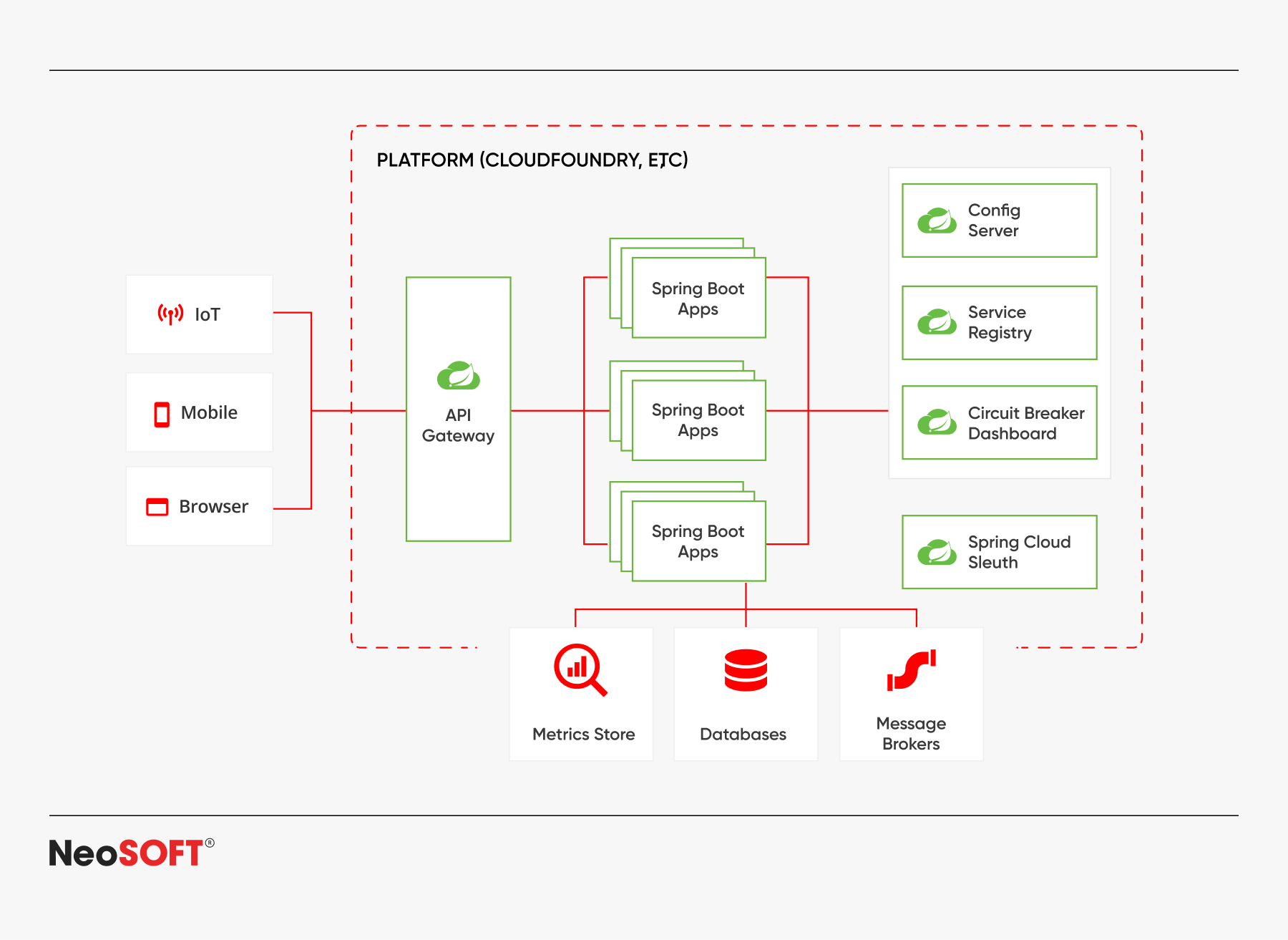Blueprint for Software Development Success: Java Applications with Microservices Architecture
December 17, 2024
Introduction
Agile, scalable, and robust software systems are essential for businesses in today’s fast-paced digital environment. This need gave rise to a new approach to application development called microservices architecture, which builds programs as a collection of small, loosely coupled, independently deployable services. Microservices, as opposed to conventional monolithic designs, allow development teams to expand components separately, provide faster development cycles, more fault tolerance, and deliver changes more quickly.
Java has been a preferred platform for creating microservices because of its strong ecosystem and large community support. It is perfect for creating modular, high-performance web applications because of its adaptability, compatibility with containerization tools, and support for established frameworks like Micronaut and Spring Boot. Additionally, Java has an established foundation for developing scalable and dependable systems due to its extensive use in enterprise settings.
Microservices architecture is emerging as a key component of contemporary software development as businesses place a greater emphasis on flexibility, scalability, and persistence in their programs. Java microservices offer the tools and techniques to create systems that satisfy present business needs and become ready for agile development and expansion, whether they are powering global online shopping platforms, streaming platforms, or banking systems.
This article discusses the advantages of adopting Java for microservices and best practices for developing scalable, resilient systems. It is aimed at Java developers, microservices specialists, IT executives, and business leaders and provides valuable insights into how to use Java tools and frameworks in order to optimize or move to a microservices architecture.
Microservices Architecture Explained
Microservices architecture refers to a method of software development in which systems are developed as a collection of small, self-contained services, each assigned a specified purpose. These services run autonomously, interact using lightweight protocols such as REST or message queues, and may be built, deployed independently, and scaled separately.
Serverless architecture is increasingly being used alongside microservices, allowing developers to deliver lightweight functionalities without having to manage server infrastructure. It supports microservices by improving scalability and lowering operational costs, particularly for event-driven or infrequently used applications.
This microservice development, as mentioned above, contrasts with monolithic design, in which all application components are closely connected and run as an individual unit, complicating scaling and upgrades.
Some of the main components are:
- Independent Services: Every service is self-contained, built with the best available technology, and focuses on a particular business capability.
- API Gateways: A centralized gateway handles cross-cutting issues like authentication, rate limitation, and logging while managing client requests and forwarding them to the relevant services.
- Decentralized Data Management: Each service typically handles its own database, encouraging loose coupling and allowing teams to select the best storage option for their needs.
In a study conducted by IBM, wherein more than 1200 software developers and industry stakeholders were surveyed, 87% of microservices users are of the opinion that adopting microservices is worth the money and work. 78% of those who already make use of microservices architecture in their operations indicated that they would increase the time, money, and effort they invested in it.
Clearly, the benefits of adopting microservices architecture far outweigh any drawbacks there may be. Combining microservices with Java can take these benefits to new heights.
Benefits of Using Microservices with Java
Scalability
Microservices enable every service to expand independently depending on its specific resource needs. This implies that highly sought after services can be expanded without affecting other areas of the system.
Java’s fast runtime as well as containerization support (via Docker and/or Kubernetes) make it easier to roll out and expand microservices across dispersed settings, assuring optimal resource usage while lowering operational costs. Moreover, even under extreme strain, high-demand services can continue to function thanks to its independent scalability.
Resilience
Each service in a microservices design is isolated, so even if one service fails, the entire application does not collapse. This isolation enables increased fault tolerance and recovery. Java frameworks like Spring Cloud give tools for building resilient systems, including circuit breakers, retries, and fallbacks, which improve service dependability even when one or more components fail.
When combined with Java’s strong exception handling, these capabilities ensure that services continue to function and that user experience is affected as little as possible.
Deployment Flexibility
Java microservices integrate neatly into CI/CD pipelines, allowing for quicker development processes, easier maintenance, and a greater frequency of releases. Jenkins, GitLab CI, and Docker enable automated testing, deployment, and scalability of multiple microservices, making sure new features or repairs are provided promptly and with low downtime.
This flexibility facilitates agile development processes, making Java-based microservices ideal for dynamic business requirements. Additionally, it enables companies to test new features or updates using methods like canary or blue-green deployments.
Technology Diversity
One of the primary benefits of building microservices in the Java programming language is the capacity to select the best and most suitable technology stack for every single service. Java’s interoperability with other programming languages and a wide number of frameworks, libraries, and tools enables developers to customize each service to meet individual needs.
Whether utilizing Spring Boot for a RESTful service, or Micronaut for lightweight microservices frameworks, or Quarkus for high-performance, low-latency projects, Java enables you to choose the best technology for each microservice architecture.
Development Speed
Microservices allow development groups to focus on smaller and isolated functions, providing features that are separate from other parts of the system’s components. The whole process of development is sped up by this autonomy, which also promotes parallel development and reduces bottlenecks.
Agile principles enable developers to work on several services concurrently, accelerating product delivery, decreasing time to market, and providing them with flexibility and scaling ability to swiftly adjust to changing needs. Due to Java’s many development tools and IDE support – such as IntelliJ IDEA and Eclipse – developers can work on complex applications more quickly and effectively.
Best Practices for Microservices with Java
Designing for Domain-Driven Development (DDD)
Domain-driven design entails leveraging limited contexts to set defined service boundaries that are linked with specific business requirements. This guarantees that services have different tasks, thus increasing manageability while decreasing overlaps. Teams can design more adaptable and scalable systems by closely aligning services with specific business function and logic. This alignment also promotes improved communication between business stakeholders and developers.
Picking the Right Frameworks
Framework selection is critical to the success of microservices. Spring Boot provides powerful corporate support, whereas Dropwizard is best suited for lightweight services. Micronaut and Quarkus thrive in cloud-native and Kubernetes environments, with quick startup times and low resource use. Selecting the appropriate framework to build microservices ensures that the services are tuned for performance and maintainability. Every framework also easily connects with Java’s extensive tool and library ecosystem.
Enabling Efficient Inter-Service Communication
The industry norm for stateless communication is for RESTful services and APIs, while gRPC provides low-latency, high-performance substitutes. RabbitMQ and Kafka are two examples of solutions that facilitate dependable messaging between services in asynchronous or event-driven systems. System performance is improved, and latency is reduced by ensuring effective communication. Communication channel optimization is essential to reducing bottlenecks in distributed systems.
Managing Data
Decentralized data management is necessary for microservices, where each service is in charge of its own database and data store. Services are kept loosely connected, but eventual consistency is maintained by patterns such as saga orchestration and event sourcing. Decentralized administration enables individual services to select the database that best suits their requirements. This versatility improves responsiveness to changing business requirements.
API Gateway Patterns
An API gateway controls routing, authentication, and rate limitation while serving as a single point of entry for external queries. Tools like Kong, Spring Cloud Gateway, and Zuul make these chores easier and increase scalability. Additionally, by centralizing sensitive processes like authorization, API gateways improve security. They also help in the consolidation of service responses for improved performance on the client side.
Monitoring and Logging
System health is ensured via efficient monitoring using platforms like Prometheus and Grafana; smaller services and inter-service problems can be debugged using distributed tracing offered by Jaeger and Zipkin. Centralized logging increases service-wide visibility. OpenTelemetry has emerged as a new monitoring and tracing standard, providing a uniform approach to observability spanning dispersed systems. These tools collaborate to identify and fix issues before they harm users. Regular monitoring also guarantees compliance with performance and uptime standards.
Security Considerations
Reliable communication between services is a key component of microservices design, and tools like TLS, JWT for authentication using tokens, and OAuth2 for authorization are frequently used. By enforcing secure coding principles and conducting regular audits of dependencies, vulnerabilities are reduced. Maintaining user confidence and safeguarding sensitive data depend heavily on these strong security measures. Frameworks like Spring Security and Keycloak offer robust implementations for securing Java-based microservices.
Testing and Quality Assurance
For isolated testing, use mock dependencies and contract testing to verify service interactions without active integrations. As the system develops, automate testing via CI/CD pipelines to guarantee quality. Thorough testing guarantees smooth operation across services and lowers risks. Automated regression testing contributes to system stability when features are added.
Challenges and Solutions
While microservices design has many benefits, it also creates new issues that must be addressed with careful planning. One key problem is the increased complexity of maintaining multiple independent services, each with their own deployment, scaling, and monitoring needs. Service mesh solutions (such as Istio and Linkerd) can help by transparently managing service discovery as well as safe communication.
Another concern is data management since each microservice typically handles its own database, potentially resulting in data consistency issues. Saga orchestration and event sourcing are two patterns that can help preserve uniformity across distributed systems whilst maintaining service autonomy.
Network latency is also important because constant interaction between services can have an influence on performance. Latency issues can be mitigated by optimizing communication between services using protocols such as gRPC and implementing caching methods (e.g. Redis).
Finally, coordinating frequent deployments and service changes can put a strain on teams. Adopting DevOps principles using tools such as Jenkins, Kubernetes, and CI/CD pipelines guarantees smooth deployments, automated testing, and improved collaboration, resulting in faster and more dependable delivery.
Frameworks & Tools for Developing Java Microservices
A popular platform for creating Java microservices, Spring Boot provides prepared templates and embedded servers, as well as smooth interaction with Spring Cloud and other tools. It offers features like cloud-native capabilities, dependency injection, and REST API development, making it easier to create stand-alone, production-ready services.
In order to containerize Java microservices and enable each service to operate in a separate environment, Docker is a necessary technology. Packaging code with all of its dependencies makes deployment easier and guarantees consistency throughout development, testing, and production.
A potent orchestration tool, Kubernetes integrates easily with many popular Java frameworks and microservices that are set up as Docker containers. It simplifies complex system management by automating service provision, load balancing, and scalability.
Built on top of Kubernetes, OpenShift offers enterprise-grade features including developer-friendly workflows, strong security, and tightly integrated CI/CD pipelines. For teams working on large-scale, cloud-native Java applications, it is very advantageous.
Together, these technologies improve Java microservices development and deployment, guaranteeing scalability, dependability, and efficiency in contemporary systems.
Conclusion
Java’s extensive network of frameworks, tools, and demonstrated scalability make it a popular choice for microservice development. Thanks to its adaptability and easy integration into contemporary DevOps processes, it enables businesses to build robust, effective systems that satisfy the needs of the ever-changing software industry.
By implementing best practices, teams may optimize performance, guarantee dependability, and future-proof their software applications against constantly evolving business requirements. These practices include domain-driven design, effective communication procedures, decentralized management of data, and strong security measures. Java’s flexibility makes it perfect for creating systems that are agile, maintainable, and scalable.
Our team of skilled experts is at the ready to support you if you’re prepared to realize the full potential of microservices or in the event you need professional advice when creating Java-based solutions. To begin developing an adaptable, effective, and future-ready IT architecture, get in touch with us today at [email protected]!






















